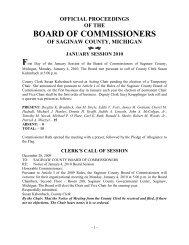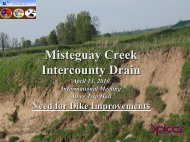The Metropolitan Transportation Planning ... - Saginaw County
The Metropolitan Transportation Planning ... - Saginaw County
The Metropolitan Transportation Planning ... - Saginaw County
Create successful ePaper yourself
Turn your PDF publications into a flip-book with our unique Google optimized e-Paper software.
<strong>The</strong> <strong>Metropolitan</strong> <strong>Transportation</strong> <strong>Planning</strong> Process: Key Issues<br />
<strong>The</strong> plan has several elements, for example:<br />
●<br />
●<br />
●<br />
●<br />
●<br />
●<br />
●<br />
●<br />
Identify policies, strategies, and projects for the future;<br />
Determine project demand for transportation services over 20 years;<br />
Focus at the systems level, including roadways, transit, non-motorized<br />
transportation, and intermodal connections;<br />
Articulate regional land use, development, housing, and employment goals<br />
and plans;<br />
Estimate costs and identify reasonably available financial sources for<br />
operation, maintenance, and capital investments (see Part II, section on<br />
financial planning);<br />
Determine ways to preserve existing roads and facilities and make efficient<br />
use of the existing system;<br />
Be consistent with the statewide transportation plan; and<br />
Be updated every five years or three years in air quality nonattainment and<br />
maintenance areas.<br />
MPOs should make special efforts to engage interested parties in the development<br />
of the plan. In cases where a metropolitan area is designated as a nonattainment<br />
or maintenance area, the plan must conform to the SIP for air quality (see section<br />
on air quality).<br />
<strong>Transportation</strong> Improvement Program (TIP): <strong>The</strong> TIP is a financially constrained threeyear<br />
program covering the most immediate implementation priorities for<br />
transportation projects and strategies from the metropolitan transportation plan. It is<br />
the region’s way of allocating its limited transportation resources among the various<br />
capital and operating needs of the area, based on a clear set of short-term<br />
transportation priorities.<br />
Under federal law, the TIP:<br />
●<br />
●<br />
●<br />
●<br />
●<br />
●<br />
Covers a minimum three-year period of investment;<br />
Is updated at least every two years;<br />
Is realistic in terms of available funding (known as a fiscally constrained TIP)<br />
and is not just a “wish list” of projects;<br />
Conforms with the SIP for air quality if the region is designated a<br />
nonattainment or maintenance area;<br />
Is approved by the MPO and the governor for air quality; and<br />
Is incorporated into the statewide transportation improvement program<br />
(STIP).<br />
How is federal transportation funding provided to metropolitan areas?<br />
<strong>The</strong> funding for transportation plans and projects comes from a variety of sources<br />
including the federal government, state governments, special authorities,<br />
assessment districts, local government contributions, impact fees, and tolls.<br />
However, in most metropolitan areas, federal funding, transferred first to the state to<br />
be distributed to metropolitan areas, is considered to be the primary funding<br />
source for plans and projects. (See appendix for a description of the most<br />
important federally aided transportation programs.) <strong>The</strong> financing provisions<br />
introduced in 1991 with the enactment of the lntermodal Surface <strong>Transportation</strong><br />
Equity Act (ISTEA) and continued in 1998 with the reauthorizing legislation known as<br />
the <strong>Transportation</strong> Equity Act for the 21st Century (TEA-21) are obtained through the<br />
Federal Highway Trust Fund and supplemented by general funds. It is important to<br />
remember that most FHWA sources of funding are sent to and administered by the<br />
State DOTs. <strong>The</strong> State DOT then allocates the money to urban and rural areas,<br />
based on local priorities and needs. Most transit funds for urban areas are sent<br />
directly from the FTA to the transit operator. Transit funds for rural areas are<br />
administered by the State DOT.


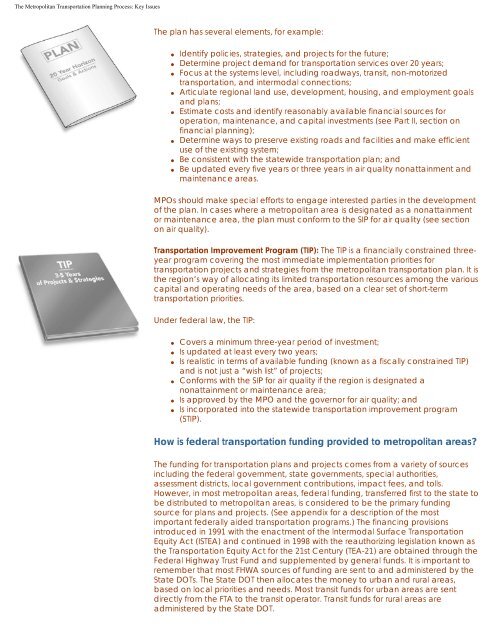
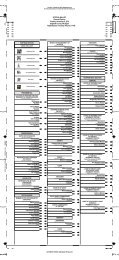
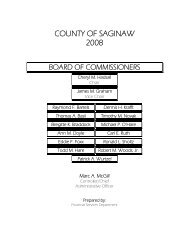
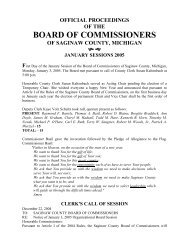
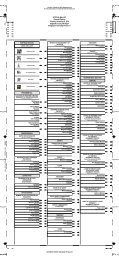

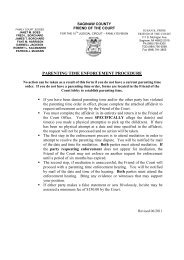
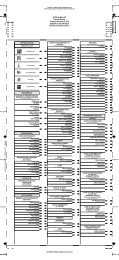


![[ Of Commissioners] - Saginaw County](https://img.yumpu.com/25951211/1/190x245/-of-commissioners-saginaw-county.jpg?quality=85)


